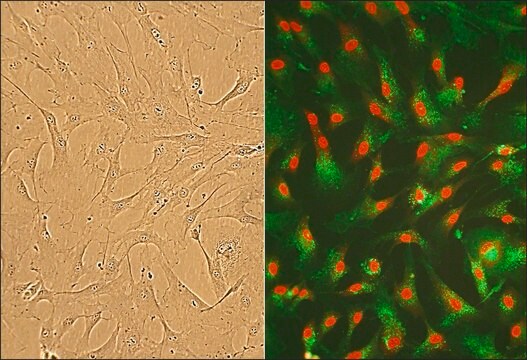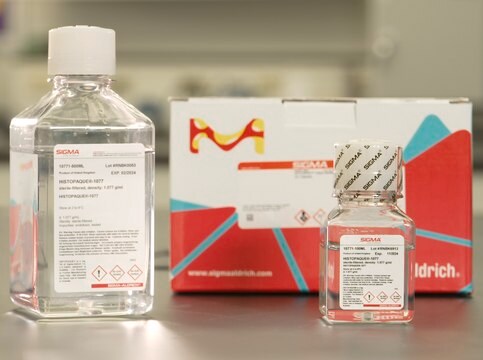300-05A
Human Coronary Artery Endothelial Cells: HCAEC, adult
Sinônimo(s):
HCAEC cells
About This Item
Produtos recomendados
fonte biológica
human coronary artery (normal)
Nível de qualidade
embalagem
pkg of 500,000 cells
fabricante/nome comercial
Cell Applications, Inc
modo de crescimento
Adherent
cariótipo
2n = 46
morfologia
Endothelial
técnica(s)
cell culture | mammalian: suitable
doença(s) relevante(s)
cardiovascular diseases
Condições de expedição
dry ice
temperatura de armazenamento
−196°C
Descrição geral
HCAEC provides an excellent model system to study all aspects of cardiovascular function and disease, and they have been utilized in dozens of research publications, for example to:
- Understand the mechanism of the anti-inflammatory properties of HDL, and demonstrate for the first time that mature miRNA can control gene expression in a cell where it is neither transcribed nor processed (Tabet, 2014)
- Study mechanisms of angiogenesis, as well as oxidative stress and inflammation related pathways in endothelia (Ji, 2009; Wang, 2011; Quinn, 2011; Hung, 2010; Rajesh, 2010; Riegel, 2011; Lin, 2013; Lloid, 2013Baley-Downs, 2012; Kapur, 2012; Melchior, 2012; Castanares-Zapatero, 2013; Hankins, 2013; Lord, 2013; dela Paz, 2013; Takai, 2013), including gender and race specific differences in patients with peripheral artery disease (Gardner, 2014)
- Elucidate molecular mechanisms of various cardiovascular risk factors, including those associated with diabetes (Vladik, 2011; Kapur, 2011; Dunn, 2013; Leucker, 2013; Liu, 2013, 2014; Morgan, 2014; Torella, 2014)
- Understand the mode of action and cardiovascular protection effects of various natural compounds, vitamins and drug candidates (Candelario, 2013; Ramirez-Sanchez, 2010, 2013; Lee, 2013; Nsimba, 2013; Di Bartolo, 2011; Baotic, 2013; Murphy, 2013; Tan, 2013; Wu, 2012), as well as caloric restriction (Csiszar, 2009, 2013)
- Develop and evaluate scaffolds and hydrogels for cardiac tissue engineering (Singelyn, 2009, 2011; Seif-Naraghi, 2010; Johnson, 2014), and new treatment strategies to prevent stent restenosis (O’Neill, 2009; O’Brien, 2010; Crowder, 2011, 2012; Eppihimer, 2013; Hiob, 2013)
- Compare effects of BMP-4 on HCAEC and Human Pulmonary Artery Endothelial Cells (HPAEC) and show that only in HCAEC BMP-4 treatment induced ROS, activated NF-kB, ICAM-1 and increased monocyte adhesiveness, explaining why its upregulation leads to atherosclerosis and hypertension in the systemic, but not pulmonary circulation (Csiszar, 2008)
Additionally, HCAEC, along with human aortic (HAOEC), carotid artery (HCtAEC), subclavian artery (HScAEC) and brachiocephalic artery (HBcAEC) have been used to demonstrate that not only blood vessels from different tissues are highly heterogeneous, they also interact differently with leukocytes during the inflammation response (Scott, 2013). The authors further showed that differential N-glycosylation of commonly expressed vascular adhesion molecules may be responsible for this heterogeneity, as well as for modulation of signaling under resting and activated inflammatory conditions. This also explains why specific vascular beds may be more or less susceptible to particular diseases or stimuli. Importantly, if cells from different sources were used, these results could not be convincingly validated due to a number of uncontrolled variables, such as age, race, genetic variability or life style choices of the donors.
Because of the complex heterogeneity that exists not only between different donors, but even between different vascular beds in the same individual, it would be prudent to confirm any new findings on primary cell lots coming from several different origins.
Origem de linhagem celular
Aplicação
Componentes
Nota de preparo
- 2nd passage, >500,000 cells in Basal Medium containing 10% FBS & 10% DMSO
- Can be cultured at least 15 doublings
Rotina de subcultura
Exoneração de responsabilidade
Código de classe de armazenamento
10 - Combustible liquids
Classe de risco de água (WGK)
WGK 3
Ponto de fulgor (°F)
Not applicable
Ponto de fulgor (°C)
Not applicable
Escolha uma das versões mais recentes:
Certificados de análise (COA)
It looks like we've run into a problem, but you can still download Certificates of Analysis from our Documentos section.
Se precisar de ajuda, entre em contato Atendimento ao cliente
Já possui este produto?
Encontre a documentação dos produtos que você adquiriu recentemente na biblioteca de documentos.
Os clientes também visualizaram
Protocolos
Human Coronary Artery Endothelial Cells (HCAEC) Culture Protocol
Nossa equipe de cientistas tem experiência em todas as áreas de pesquisa, incluindo Life Sciences, ciência de materiais, síntese química, cromatografia, química analítica e muitas outras.
Entre em contato com a assistência técnica






